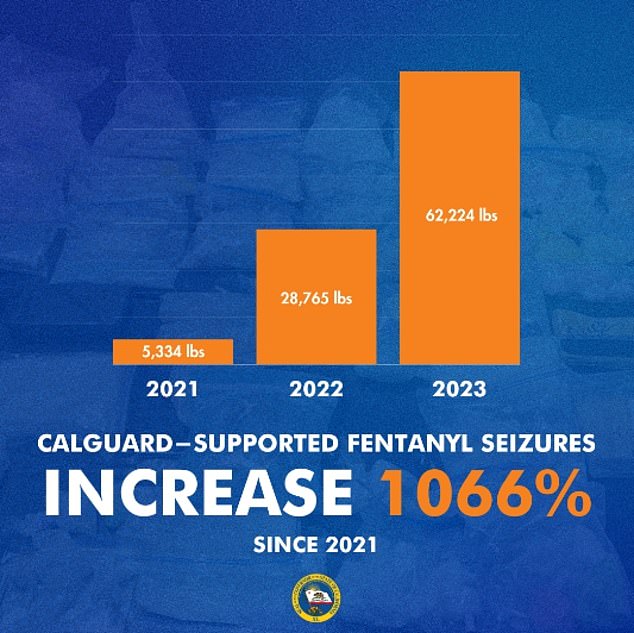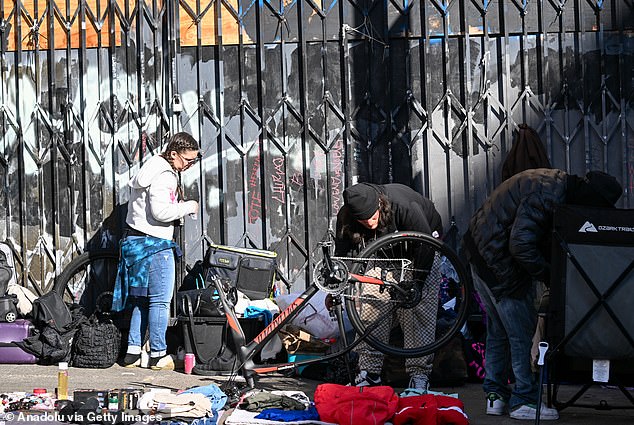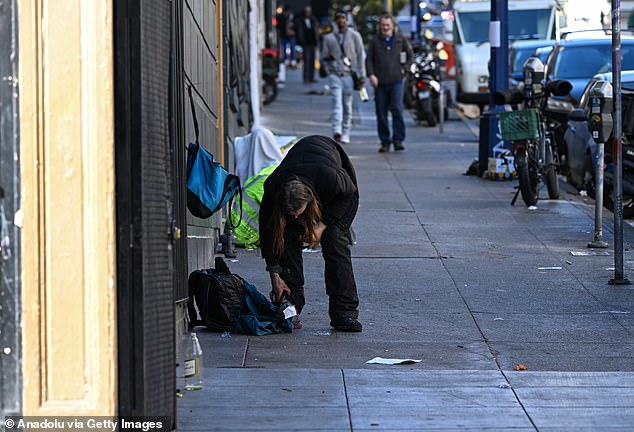The California National Guard intercepted thousands of pounds of deadly fentanyl at ports of entry, enough to kill the entire world’s population “almost twice as many,” according to the governor.
The National Guard, or CalGuard, worked with other government drug interdiction offices to seize a record 62,000 pounds of fentanyl, an increase of 1,066 percent from the 5,300 pounds seized in 2021.
It is unclear whether more were seized last year due to increased numbers of agents or whether drug traffickers are massively increasing production.
The rush of fentanyl into the drug supply began in the early 2010s, the start of what health experts and government agencies have called the third wave of the opioid epidemic, which claimed the lives of more than 100,000 Americans in 2022 alone. Fentanyl was involved in 70 percent of those deaths.

The California National Guard made record seizures of more than 62,000 pounds of fentanyl in 2023, an increase of 1,066 percent from the 5,300 pounds seized in 2021.


One of the most severely affected communities is the city of San Francisco, where the growing fentanyl and xylazine crisis is taking a devastating toll on its residents.
Just two milligrams of fentanyl (equivalent to about 10 grains of table salt) is a fatal dose.
The drug has infiltrated the illicit drug supply because it is relatively cheap to manufacture and, in most cases, pills sold on the street and advertised as something else, such as a benzodiazepine, are laced with the drug. .
California Governor Gavin Newsom saying: ‘Fentanyl is a poison and does not belong in our communities. California is cracking down—increasing seizures, expanding access to substance abuse treatment, and holding drug traffickers accountable—to combat the immeasurable harm opioids have caused our communities.’
In 2021, there were nearly 6,000 opioid-related overdose deaths in California. In just three years, between 2019 and 2021, opioid-related deaths in California increased 121 percent, according to the state health department. The vast majority of these deaths were related to fentanyl.
One of the most severely affected communities is the city of San Francisco, where a desperate situation is unfolding in real time and is evident in grim images showing people high on drugs and slumped in the street or actively using drugs outdoors.
Governor Newsom deployed the state National Guard and the California Highway Patrol there in May of last year.
The crisis in the Tenderloin and South of Market neighborhoods is also being fueled by the rise of the veterinary tranquilizer Xylazine sold on the street.
More than 800 people died from overdoses in San Francisco in 2023, an all-time high. The vast majority of those deaths (653) were attributed to fentanyl.


The city reported 806 overdose deaths in 2023, surpassing its highest year on record, 2020, when 726 people died.
Governor Newsom added: “California is taking aggressive action: increasing seizures, expanding access to substance abuse treatment, and holding drug traffickers accountable to combat the immeasurable harm opioids have caused our communities.”
Several counties have even launched a new and unprecedented method to reduce the magnitude of the crisis: accuse drug dealers of murder.
Since taking office in 2019, Governor Newsom has overseen an investment of more than $1 billion to combat opioid trafficking, including fentanyl, and expand access to treatment programs for people with opioid use disorder.
Among those efforts is a plan to work with CalRx, which will be awarded $30 million to boost the distribution of naloxone overdose reversal kits, which involve a nasal spray that binds to opioid receptors in the brain, displacing the opioids present and blocking their effects.
The spray, commonly known by its brand name Narcan, quickly reverses overdose-induced respiratory distress, restoring breathing. However, using the spray is not the end all be all. Its goal is to reduce the most acute effects and give the person enough time to call an ambulance and get help from medical professionals.
The problem is far from limited to California, and the DEA continues to seize thousands of pounds of drugs each year.
Last year, federal officials seized nearly 80 million counterfeit fentanyl pills and nearly 12,000 pounds of fentanyl powder, the DEA reported.
Only in 2024, the DEA has intercepted more than 19.8 million pills containing fentanyl and more than 1,215 pounds of the drug in powder form.
